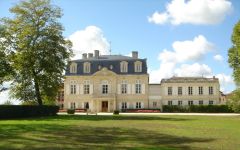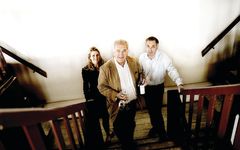Chateau Pontet-Canet Hauts de Pontet-Canet 2006


Product Details
Your Rating
Somm Note
Winemaker Notes
Cabernet Sauvignon 60%, Merlot 38%, Cabernet Franc 1%, Petit-Verdot 1%





Jean Francois Pontet, Royal Master of the Horse in the early 18th Century, bought and consolidated several plots of land located northwest of Pauillac. Several years later, in 1750, his descendants bought neighboring vineyards in an area named "Canet", thus creating one of the largest estates in the entire Medoc. Chateau Pontet-Canet's topography and soil predestined it to produce great wine.
In 1865, the noted wine shipper Hermann Cruse acquired the chateau and its 120 hectares of vones. The Cruse dynasty provided the financial means to make one of the greatest wines in the Medoc. In 1975, Guy Tesseron, solidly implanted in the Cognac region, and owner of Lafon Rochet in St-Estephe, purchsed Pontet-Canet.
The family's avowed ambition is to pass on the history of Chateau Pontet-Canet and secure its future. Today, it is Guy Tesseron’s descendants who own the estate today: Alfred and his nieces Mélanie and Philippine, daughters of his late brother Gérard. Together, they have the same outlook. Alfred shares his vision of the estate with Mélanie, passing on to her its traditions, his outlook on vinegrowing and his passion for wine.
In 2004, the year of the first biodynamic trial which took place on 14 hectares, the wines were radiant, tighter and brighter. Alfred urged Jean-Michel to go further. The estate was fully converted to biodynamic agriculture. This decision became a commitment and a challenge, but also a first for a Médoc Classified Growth.
Since then, with each vintage comes new knowledge, furthering the understanding of the terroir in a profound way. The vine’s resistance to disease is better known today, the understanding of how different parcels behave has improved, always in keeping with biodynamic principles. It requires sincerity, pragmatism and transparency: in a nutshell, absolute dedication.
The wines of Chateau Pontet-Canet obtained organic certification from Ecocert and biodynamic certification from Biodyvin in 2010 and from Demeter in 2014.
A shared state of mind and a particular sensitivity are the key factors which have propelled Chateau Pontet-Canet to the summit of Bordeaux wines in recent years. They are the expression of the Tesseron family’s quiet determination to ensure continuity over the long term.

One of the world’s most classic and popular styles of red wine, Bordeaux-inspired blends have spread from their homeland in France to nearly every corner of the New World. Typically based on either Cabernet Sauvignon or Merlot and supported by Cabernet Franc, Malbec and Petit Verdot, the best of these are densely hued, fragrant, full of fruit and boast a structure that begs for cellar time. Somm Secret—Blends from Bordeaux are generally earthier compared to those from the New World, which tend to be fruit-dominant.

The leader on the Left Bank in number of first growth classified producers within its boundaries, Pauillac has more than any of the other appellations, at three of the five. Chateau Lafite Rothschild and Mouton Rothschild border St. Estephe on its northern end and Chateau Latour is at Pauillac’s southern end, bordering St. Julien.
While the first growths are certainly some of the better producers of the Left Bank, today they often compete with some of the “lower ranked” producers (second, third, fourth, fifth growth) in quality and value. The Left Bank of Bordeaux subscribes to an arguably outdated method of classification that goes back to 1855. The finest chateaux in that year were judged on the basis of reputation and trading price; changes in rank since then have been miniscule at best. Today producers such as Chateau Pontet-Canet, Chateau Grand Puy-Lacoste, Chateau Lynch-Bages, among others (all fifth growth) offer some of the most outstanding wines in all of Bordeaux.
Defining characteristics of fine wines from Pauillac (i.e. Cabernet-based Bordeaux Blends) include inky and juicy blackcurrant, cedar or cigar box and plush or chalky tannins.
Layers of gravel in the Pauillac region are key to its wines’ character and quality. The layers offer excellent drainage in the relatively flat topography of the region allowing water to run off into “jalles” or streams, which subsequently flow off into the Gironde.
